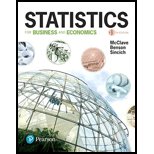
Concept explainers
Cooling method for gas turbines. Refer to the Journal of Engineering for Gas Turbines and Power (January 2005) study of gas turbines augmented with high-pressure inlet fogging, Exercise 7.94 (p. 407). The researchers classified gas turbines into three categories: traditional, advanced, and aeroderivative. Summary statistics on heat rate (kilojoules per kilowatt per hour) for each of the three types of gas turbines are shown in the Minitab printout (at the top of the next page).
- a. Is there sufficient evidence of a difference between the mean heat rates of traditional augmented gas turbines and aeroderivative augmented gas turbines? Test using α = .05.
- b. Is there sufficient evidence of a difference between the mean heat rates of advanced augmented gas turbines and aeroderivative augmented gas turbines? Test using α = .05.
- c. Conduct a test (at α = .05 ) for equality of heat rate variances for traditional and aeroderivative augmented gas turbines. Use the result to make a statement about the validity of the inference derived in part a.
- d. Conduct a test (at α = .05 ) for equality of heat rate variances for advanced and aeroderivative augmented gas turbines. Use the result to make a statement about the validity of the inference derived in part b.

Want to see the full answer?
Check out a sample textbook solution
Chapter 8 Solutions
Statistics for Business and Economics (13th Edition)
Additional Math Textbook Solutions
APPLIED STAT.IN BUS.+ECONOMICS
Probability And Statistical Inference (10th Edition)
Calculus: Early Transcendentals (2nd Edition)
Elementary Algebra For College Students (10th Edition)
Calculus for Business, Economics, Life Sciences, and Social Sciences (14th Edition)
- Please give with explanationarrow_forwardnot use ai pleasearrow_forwardand u (C1, C2) = 1/2 = f) Derive analytically and show graphically the solution under other util- ity functions such as u (C1, C2) ac₁+bc2 where a, b > 0, u (C1, C2) = ac₁+bc1/2 acbc2 (assume that the agent is sufficiently rich to avoid the corner solution). What of these utility functions reflects best your own preferences (or indicate other utility function that represent your pref- erences).arrow_forward
 Managerial Economics: Applications, Strategies an...EconomicsISBN:9781305506381Author:James R. McGuigan, R. Charles Moyer, Frederick H.deB. HarrisPublisher:Cengage Learning
Managerial Economics: Applications, Strategies an...EconomicsISBN:9781305506381Author:James R. McGuigan, R. Charles Moyer, Frederick H.deB. HarrisPublisher:Cengage Learning Managerial Economics: A Problem Solving ApproachEconomicsISBN:9781337106665Author:Luke M. Froeb, Brian T. McCann, Michael R. Ward, Mike ShorPublisher:Cengage Learning
Managerial Economics: A Problem Solving ApproachEconomicsISBN:9781337106665Author:Luke M. Froeb, Brian T. McCann, Michael R. Ward, Mike ShorPublisher:Cengage Learning
 Economics (MindTap Course List)EconomicsISBN:9781337617383Author:Roger A. ArnoldPublisher:Cengage Learning
Economics (MindTap Course List)EconomicsISBN:9781337617383Author:Roger A. ArnoldPublisher:Cengage Learning





